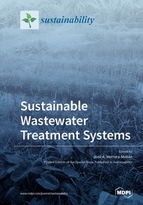Sustainable Wastewater Treatment Systems
A special issue of Sustainability (ISSN 2071-1050). This special issue belongs to the section "Environmental Sustainability and Applications".
Deadline for manuscript submissions: closed (30 April 2019) | Viewed by 75623
Special Issue Editor
Interests: wastewater treatment; constructed wetland; biofilters; ponds; advanced oxidation technologies; wastewater disinfection
Special Issues, Collections and Topics in MDPI journals
Special Issue Information
Dear Colleagues,
The impact of untreated wastewater discharges into the environment is one of the greatest challenges facing modern societies. Phenomena such as eutrophication, hypoxia or the transmission of diseases alter natural equilibria and threaten the health of the environment, and as a consequent, that of humankind. Therefore, the treatment and reuse of wastewater is an obligation if we want to avoid its negative consequences and turn them into opportunities. Wastewater contains valuable resources such as organic matter and nutrients that can be reused in agriculture, the activity that demands the most water globally. However, the treatment methods must be environmentally friendly, that is, have a low carbon footprint and consume few resources. In addition to being as well as efficient, robust and simple, they must be environmentally and economically sustainable, so that they can be applied in remote places, in adverse conditions and by the poorest people. Therefore, the goal of this special issue is to improve our understanding of the development of sustainable wastewater treatment methods.
Prof. Dr. José Alberto Herrera-MeliánGuest Editor
Manuscript Submission Information
Manuscripts should be submitted online at www.mdpi.com by registering and logging in to this website. Once you are registered, click here to go to the submission form. Manuscripts can be submitted until the deadline. All submissions that pass pre-check are peer-reviewed. Accepted papers will be published continuously in the journal (as soon as accepted) and will be listed together on the special issue website. Research articles, review articles as well as short communications are invited. For planned papers, a title and short abstract (about 100 words) can be sent to the Editorial Office for announcement on this website.
Submitted manuscripts should not have been published previously, nor be under consideration for publication elsewhere (except conference proceedings papers). All manuscripts are thoroughly refereed through a single-blind peer-review process. A guide for authors and other relevant information for submission of manuscripts is available on the Instructions for Authors page. Sustainability is an international peer-reviewed open access semimonthly journal published by MDPI.
Please visit the Instructions for Authors page before submitting a manuscript. The Article Processing Charge (APC) for publication in this open access journal is 2400 CHF (Swiss Francs). Submitted papers should be well formatted and use good English. Authors may use MDPI's English editing service prior to publication or during author revisions.
Keywords
- wastewater
- sustainable treatment
- disinfection
- reclaimed wastewater reuse
- grey water
- wastewater irrigation
- constructed wetland
- pond






